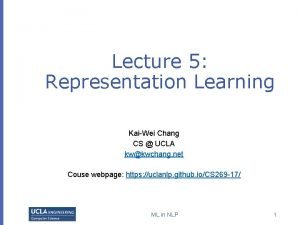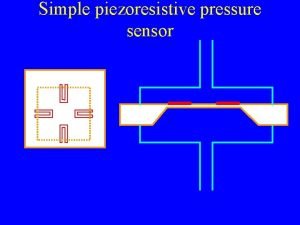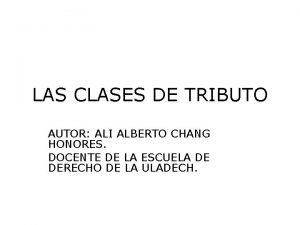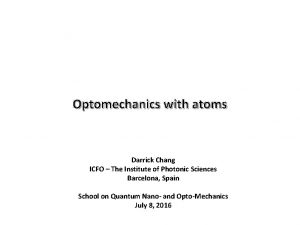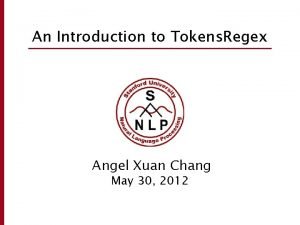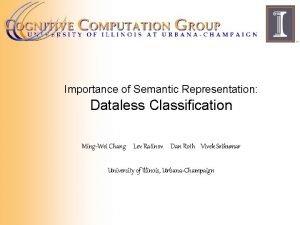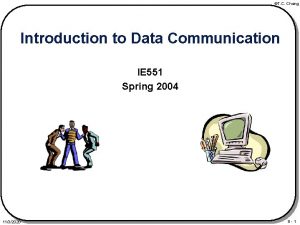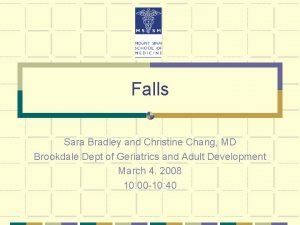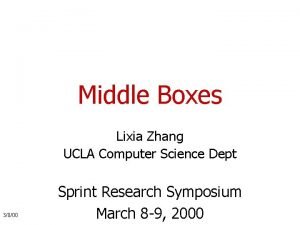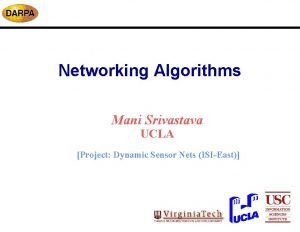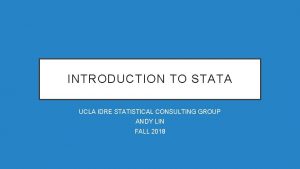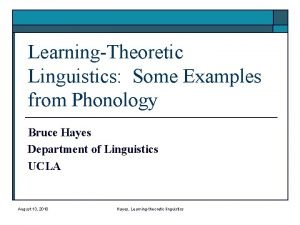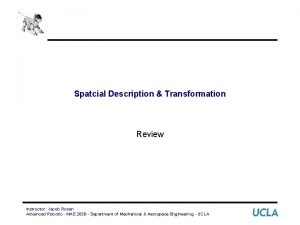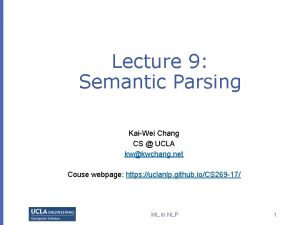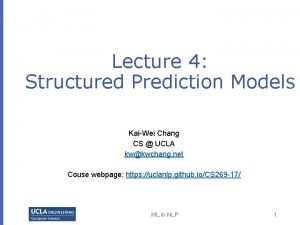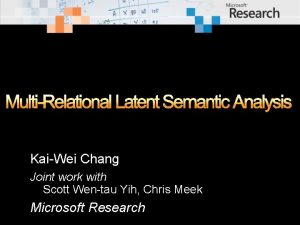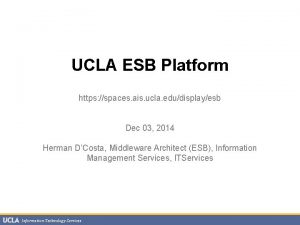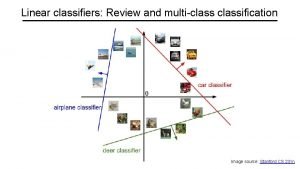Lecture 3 MultiClassification KaiWei Chang CS UCLA kwkwchang















































































- Slides: 79

Lecture 3: Multi-Classification Kai-Wei Chang CS @ UCLA kw@kwchang. net Couse webpage: https: //uclanlp. github. io/CS 269 -17/ ML in NLP 1

Previous Lecture v CS 6501 Lecture 3 2

This Lecture v Multiclassification overview v Reducing multiclass to binary v One-against-all & One-vs-one v Error correcting codes v Training a single classifier v Multiclass Perceptron: Kesler’s construction v Multiclass SVMs: Crammer&Singer formulation v Multinomial logistic regression CS 6501 Lecture 3 3

What is multiclass v CS 6501 Lecture 3 4

Multi-class Applications in NLP? ML in NLP 5

Two key ideas to solve multiclass v Reducing multiclass to binary v Decompose the multiclass prediction into multiple binary decisions v Make final decision based on multiple binary classifiers v Training a single classifier v Minimize the empirical risk v Consider all classes simultaneously CS 6501 Lecture 3 6

Reduction v. s. single classifier v Reduction v Future-proof: binary classification improved so does muti-class v Easy to implement v Single classifier v Global optimization: directly minimize the empirical loss; easier for joint prediction v Easy to add constraints and domain knowledge CS 6501 Lecture 3 7

A General Formula v input model parameters output space CS 6501 Lecture 3 8

This Lecture v Multiclassification overview v Reducing multiclass to binary v One-against-all & One-vs-one v Error correcting codes v Training a single classifier v Multiclass Perceptron: Kesler’s construction v Multiclass SVMs: Crammer&Singer formulation v Multinomial logistic regression CS 6501 Lecture 3 9

One against all strategy CS 6501 Lecture 3 10

One against All learning v Multiclassifier v Function f : Rn {1, 2, 3, . . . , k} v Decompose into binary problems CS 6501 Lecture 3 11

One-again-All learning algorithm v CS 6501 Lecture 3 12

One against All learning v Multiclassifier v Function f : Rn {1, 2, 3, . . . , k} v Decompose into binary problems Ideal case: only the correct label will have a positive score CS 6501 Lecture 3 13

One-again-All Inference v CS 6501 Lecture 3 14

One-again-All analysis v Not always possible to learn v Assumption: each class individually separable from all the others v No theoretical justification v Need to make sure the range of all classifiers is the same – we are comparing scores produced by K classifiers trained independently. v Easy to implement; work well in practice CS 6501 Lecture 3 15

One v. s. One (All against All) strategy CS 6501 Lecture 3 16

One v. s. One learning v Multiclassifier v Function f : Rn {1, 2, 3, . . . , k} v Decompose into binary problems Test Training CS 6501 Lecture 3 17

One-v. s-One learning algorithm v CS 6501 Lecture 3 18

One-v. s-One Inference algorithm v Decision Options: v More complex; each label gets k-1 votes v Output of binary classifier may not cohere. v Majority: classify example x to take label i if i wins on x more often than j (j=1, …k) v A tournament: start with n/2 pairs; continue with winners CS 6501 Lecture 3 19

Classifying with One-vs-one Tournament Majority Vote 1 red, 2 yellow, 2 green ? All are post-learning and might cause weird stuff CS 6501 Lecture 3 20

One-v. s. -one Assumption v Every pair of classes is separable It is possible to separate all k classes with the O(k 2) classifiers Decision Regions CS 6501 Lecture 3 21

Comparisons v CS 6501 Lecture 3 22

Problems with Decompositions v Learning optimizes over local metrics v Does not guarantee good global performance v We don’t care about the performance of the local classifiers v Poor decomposition poor performance v Difficult local problems v Irrelevant local problems v Efficiency: e. g. , All vs. One vs. All v Not clear how to generalize multi-class to problems with a very large # of output CS 6501 Lecture 3 23

Still an ongoing research direction Key questions: v How to deal with large number of classes v How to select “right samples” to train binary classifiers v Error-correcting tournaments [Beygelzimer, Langford, Ravikumar 09] v Logarithmic Time One-Against-Some [Daume, Karampatziakis, Langford, Mineiro 16] v Label embedding trees for large multi-class tasks. [Bengio, Weston, Grangier 10] v… CS 6501 Lecture 3 24

Decomposition methods: Summary v General Ideas: v Decompose the multiclass problem into many binary problems v Prediction depends on the decomposition v Constructs the multiclass label from the output of the binary classifiers v Learning optimizes local correctness v Each binary classifier don’t need to be globally correct and isn’t aware of the prediction procedure CS 6501 Lecture 3 25

This Lecture v Multiclassification overview v Reducing multiclass to binary v One-against-all & One-vs-one v Error correcting codes v Training a single classifier v Multiclass Perceptron: Kesler’s construction v Multiclass SVMs: Crammer&Singer formulation v Multinomial logistic regression CS 6501 Lecture 3 26

Revisit One-again-All learning algorithm v CS 6501 Lecture 3 27

Observation v CS 6501 Lecture 3 28

Perceptron-style algorithm v CS 6501 Lecture 3 29

A Perceptron-style Algorithm How to analyze this algorithm and simplify the update rules? v CS 6501 Lecture 3 30

Linear Separability with multiple classes v ? ? multiple models v. s. multiple data points CS 6501 Lecture 3 31

Kesler construction Assume we have a multi-class problem with K class and n features. v CS 6501 Lecture 3 32

Kesler construction Assume we have a multi-class problem with K class and n features. v CS 6501 Lecture 3 33

Kesler construction Assume we have a multi-class problem with K class and n features. v CS 6501 Lecture 3 34

Kesler construction Assume we have a multi-class problem with K class and n features. v CS 6501 Lecture 3 35

Kesler construction Assume we have a multi-class problem with K class and n features. CS 6501 Lecture 3 36

Linear Separability with multiple classes CS 6501 Lecture 3 37

How can we predict? For input an input x, the model predict label is 3 CS 6501 Lecture 3 38

How can we predict? For input an input x, the model predict label is 3 CS 6501 Lecture 3 39

Constraint Classification v x -x Transform Examples 2>4 2>1 2>3 2>4 CS 6501 Lecture 3 40

A Perceptron-style Algorithm How to interpret this update rule? v CS 6501 Lecture 3 41

An alternative training algorithm v CS 6501 Lecture 3 42

A Perceptron-style Algorithm How to interpret this update rule? v CS 6501 Lecture 3 43

A Perceptron-style Algorithm How to interpret this update rule? v CS 6501 Lecture 3 44

A Perceptron-style Algorithm How to interpret this update rule? v CS 6501 Lecture 3 45

Consider multiclass margin CS 6501 Lecture 3 46

Marginal constraint classifier v Goal: for every (x, y) in the training data set CS 6501 Lecture 3 47

A Perceptron-style Algorithm How to interpret this update rule? v CS 6501 Lecture 3 48

Remarks v This approach can be generalized to train a ranker; in fact, any output structure v We have preference over label assignments v E. g. , rank search results, rank movies / products CS 6501 Lecture 3 49

A peek of a generalized Perceptron model Structured output Structural prediction/Inference Structural loss Model update v CS 6501 Lecture 3 50

Recap: A Perceptron-style Algorithm v CS 6501 Lecture 3 51

Recap: Kesler construction Assume we have a multi-class problem with K class and n features. v CS 6501 Lecture 3 52

Geometric interpretation # features = n; # classes = K CS 6501 Lecture 3 53

Recap: A Perceptron-style Algorithm How to interpret this update rule? v CS 6501 Lecture 3 54

Multi-category to Constraint Classification v Multiclass v (x, A) (x, (A>B, A>C, A>D) ) v Multilabel v (x, (A, B)) (x, ( (A>C, A>D, B>C, B>D) ) v Label Ranking v (x, (5>4>3>2>1)) (x, ( (5>4, 4>3, 3>2, 2>1) ) CS 6501 Lecture 3 55

Generalized constraint classifiers v In all cases, we have examples (x, y) with y Sk v Where Sk : partial order over class labels {1, . . . , k} v defines “preference” relation ( > ) for class labeling v Consequently, the Constraint Classifier is: h: X Sk v h(x) is a partial order v h(x) is consistent with y if (i<j) y (i<j) h(x) Just like in the multiclass we learn one wi Rn for each label, the same is done for multi-label and ranking. The weight vectors are updated according with the requirements from y Sk CS 6501 Lecture 3 56

Multi-category to Constraint Classification Solving structured prediction problems by ranking algorithms v Multiclass v (x, A) (x, (A>B, A>C, A>D) ) v Multilabel v (x, (A, B)) (x, ( (A>C, A>D, B>C, B>D) ) v Label Ranking v (x, (5>4>3>2>1)) (x, ( (5>4, 4>3, 3>2, 2>1) ) y Sk h: X Sk CS 6501 Lecture 3 57

Properties of Construction (Zimak et. al 2002, 2003) v Can learn any argmax wi. x function (even when i isn’t linearly separable from the union of the others) v Can use any algorithm to find linear separation v Perceptron Algorithm v ultraconservative online algorithm [Crammer, Singer 2001] v Winnow Algorithm v multiclass winnow [ Masterharm 2000 ] v Defines a multiclass margin by binary margin in RKN v multiclass SVM [Crammer, Singer 2001] CS 6501 Lecture 3 58

This Lecture v Multiclassification overview v Reducing multiclass to binary v One-against-all & One-vs-one v Error correcting codes v Training a single classifier v Multiclass Perceptron: Kesler’s construction v Multiclass SVMs: Crammer&Singer formulation v Multinomial logistic regression CS 6501 Lecture 3 59

Recall: Margin for binary classifiers v The margin of a hyperplane for a dataset is the distance between the hyperplane and the data point nearest to it. - -- -- - + + ++ Margin with respect to this hyperplane CS 6501 Lecture 3 60

Multi-class SVM v CS 6501 Lecture 3 61

Multiclass Margin CS 6501 Lecture 3 62

Multiclass SVM (Intuition) v Binary SVM v Maximize margin. Equivalently, Minimize norm of weights such that the closest points to the hyperplane have a score 1 v Multiclass SVM v Each label has a different weight vector (like one-vs-all) v Maximize multiclass margin. Equivalently, Minimize total norm of the weights such that the true label is scored at least 1 more than the second best one CS 6501 Lecture 3 63

Multiclass SVM in the separable case Recall hard binary SVM Size of the weights. Effectively, regularizer The score for the true label is higher than the score for any other label by 1 CS 6501 Lecture 3 64

Multiclass SVM: General case Size of the weights. Effectively, regularizer The score for the true label is higher than the score for any other label by 1 Total slack. Effectively, don’t allow too many examples to violate the margin constraint Slack variables. Not all examples need to satisfy the margin constraint. Slack variables can only be positive CS 6501 Lecture 3 65

Multiclass SVM: General case Size of the weights. Effectively, regularizer The score for the true label is higher than the score for any other label by 1 - » i Total slack. Effectively, don’t allow too many examples to violate the margin constraint Slack variables. Not all examples need to satisfy the margin constraint. Slack variables can only be positive CS 6501 Lecture 3 66

Recap: An alternative SVM formulation v Regularization term CS 6501 Lecture 3 Empirical loss 67

Rewrite it as unconstraint problem v CS 6501 Lecture 3 68

Multiclass SVM v Generalizes binary SVM algorithm v If we have only two classes, this reduces to the binary (up to scale) v Comes with similar generalization guarantees as the binary SVM v Can be trained using different optimization methods v Stochastic sub-gradient descent can be generalized CS 6501 Lecture 3 69

Exercise! v Write down SGD for multiclass SVM v Write down multiclas SVM with Kesler construction CS 6501 Lecture 3 70

This Lecture v Multiclassification overview v Reducing multiclass to binary v One-against-all & One-vs-one v Error correcting codes v Training a single classifier v Multiclass Perceptron: Kesler’s construction v Multiclass SVMs: Crammer&Singer formulation v Multinomial logistic regression CS 6501 Lecture 3 71

Recall: (binary) logistic regression v CS 6501 Lecture 3 72

(multi-class) log-linear model Partition function v This often called soft-max CS 6501 Lecture 3 73

Softmax v CS 6501 Lecture 3 74

Example S(dog)=. 5; s(cat)=1; s(mouse)=0. 3; s(duck)=-0. 2 1 0. 8 0. 6 0. 4 0. 2 0 Dog -0. 2 Cat Mouse (hard) max (�� → 0) softmax (�� =0. 5) Duck -0. 4 score softmax CS 6501 Lecture 3 softmax (�� =2) 75

Log linear model v Linear function Except this term CS 6501 Lecture 3 76

Maximum log-likelihood estimation v CS 6501 Lecture 3 77

Maximum a posteriori v Can you use Kesler construction to rewrite this formulation? CS 6501 Lecture 3 78

Comparisons v CS 6501 Lecture 3 79
 Kai wei chang
Kai wei chang Kaiwei chang
Kaiwei chang Kai wei chang
Kai wei chang Mitchell chang ucla
Mitchell chang ucla 01:640:244 lecture notes - lecture 15: plat, idah, farad
01:640:244 lecture notes - lecture 15: plat, idah, farad Ai yi fan
Ai yi fan Paoti chang
Paoti chang Fay chang
Fay chang Adxl 50
Adxl 50 Alberto chang
Alberto chang Chia hui chang
Chia hui chang Darrick chang icfo
Darrick chang icfo Chúa chăn nuôi tôi tôi chẳng thiếu thốn chi
Chúa chăn nuôi tôi tôi chẳng thiếu thốn chi Ksk+
Ksk+ Chang wah technology
Chang wah technology Kerjasama kata majmuk
Kerjasama kata majmuk Remco chang
Remco chang Bor-yuh evan chang
Bor-yuh evan chang Chẳng nhìn thấy ve đâu
Chẳng nhìn thấy ve đâu Angel x chang
Angel x chang Joe chang
Joe chang Hee chang trading co ltd
Hee chang trading co ltd Chớ mang ách chung với kẻ chẳng tin
Chớ mang ách chung với kẻ chẳng tin Ming-wei chang
Ming-wei chang Jichuan chang
Jichuan chang Peter chang jewellery
Peter chang jewellery Chang'an
Chang'an Chia hui chang
Chia hui chang Chang pui chung memorial school
Chang pui chung memorial school Chang
Chang Wilke chang
Wilke chang Eileen chang love in a fallen city summary
Eileen chang love in a fallen city summary Ching chang walla song
Ching chang walla song Chang horing
Chang horing Conrad chang
Conrad chang Tc chang
Tc chang Winnie chang fiu
Winnie chang fiu Chang g lai
Chang g lai Sara bradley md
Sara bradley md Chemistry by raymond chang 10th edition
Chemistry by raymond chang 10th edition Chẳng may em đánh vỡ một lọ hoa đẹp
Chẳng may em đánh vỡ một lọ hoa đẹp Fay chang google
Fay chang google Chang'an
Chang'an Thêu lát khoán vảy
Thêu lát khoán vảy Lpity
Lpity Hạng a cháng là ai
Hạng a cháng là ai Phchang
Phchang Najdlhšia ázijská rieka
Najdlhšia ázijská rieka Ao and chang language
Ao and chang language Chang pao chinese clothing
Chang pao chinese clothing Rong chang dictation
Rong chang dictation Requirements engineering a roadmap
Requirements engineering a roadmap Joo yeun chang
Joo yeun chang Youngho chang
Youngho chang Chang cgi
Chang cgi Khởi nghĩa chàng lía nổ ra ở đâu
Khởi nghĩa chàng lía nổ ra ở đâu Johan chang
Johan chang Cs 111 ucla
Cs 111 ucla John cho ucla
John cho ucla Ucla web irb
Ucla web irb Ucla ece graduate
Ucla ece graduate Kevin eagan ucla
Kevin eagan ucla Arthur choi ucla
Arthur choi ucla Lixia zhang ucla
Lixia zhang ucla Mani srivastava
Mani srivastava Ucla ctrc
Ucla ctrc Ucla health leadership
Ucla health leadership Ron hays ucla
Ron hays ucla Ucla stata
Ucla stata Ucla masters entry nursing
Ucla masters entry nursing Ucla epass
Ucla epass Bruce hayes
Bruce hayes Ucla poster template
Ucla poster template Ucla applicant portal
Ucla applicant portal John cho ucla
John cho ucla Spatcial
Spatcial Ucla atlas
Ucla atlas Ucla natural language processing
Ucla natural language processing Ucla radiation oncology westwood
Ucla radiation oncology westwood Ucla efan
Ucla efan

